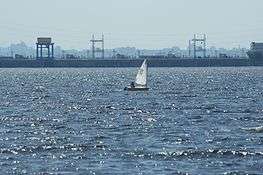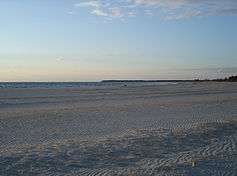Kiev Reservoir
| Kiev Reservoir | |
|---|---|
|
| |
| Location | Kiev (to the north), Kiev Oblast, Ukraine |
| Coordinates | 50°49′12″N 30°27′49″E / 50.82000°N 30.46361°ECoordinates: 50°49′12″N 30°27′49″E / 50.82000°N 30.46361°E |
| Type | Hydroelectric reservoir |
| Primary inflows | Dnieper River |
| Primary outflows | Dnieper River |
| Basin countries | Russia, Belarus, Ukraine |
| Max. length | 110 km (68 mi) |
| Max. width | 12 km (7.5 mi) |
| Surface area | 922 km2 (356 sq mi) |
| Max. depth | 8 m (26 ft) |
| Water volume | 3.7 km3 (0.89 cu mi) |
| Surface elevation | 99 m (325 ft) |


The Kiev Reservoir (Ukrainian: Київське водосховище, Kyyivs’ke vodoskhovyshche), locally the Kiev Sea, is a large water reservoir located on the Dnieper River in Ukraine. Named after the city of Kiev, which lies to the south, it covers a total area of 922 square kilometres (356 sq mi) within the Kiev Oblast. The reservoir was formed in 1960-1966, as a result of the Kiev Hydroelectric Power Plant dam being built at Vyshhorod. The reservoir is mainly used for hydroelectricity generation, industrial and public consumption, and irrigation.
The reservoir is 110 km in length, 12 km in width, has a depth of four to eight meters, a volume of 3.7 km3 (0.89 cu mi), and a usable volume of 1.2 km3 (0.29 cu mi). The reservoir, together with the Kakhovka Reservoir, the Dnieper Reservoir, the Dniprodzerzhynsk Reservoir, the Kremenchuk Reservoir, and the Kaniv Reservoir, has created a deep-water route on the river. However, the construction has also contributed to significant environmental problems such as the diminished flow velocity which reduces water oxygenation, and has a negative result on the balance of aquatic life forms. Also, during its construction some nearby villages were flooded. One of these was Teremtsi, where the residents of the village persuaded Soviet authorities to let them stay, only to be evacuated later in 1986.
Safety issues
Like all Dnieper reservoirs, Kiev reservoir poses potential threat of tremendous flooding if its dam is destroyed. Moreover, it contains additional major threat - after the Chernobyl Nuclear Disaster in 1986, radionuclides washed away by rains badly contaminated the bottom silt of the reservoir. During the years following the disaster, there were suggestions to drain the reservoir because it was too shallow. It appeared that, if done, this might have created the threat of radioactive dust travelling by wind, possibly affecting Europe.
A similar threat is permanently discussed regarding the potential destruction of the reservoir's dam (as a result of natural accident or terrorist damage). But the authorities continue to dismiss such dangers as unreal, claiming to be in full control of the dam's safety. However, serious concerns were raised in 2005, when a fake terrorist alert was made.
 |
| |
|
See also
- Threat of the Dnieper reservoirs
- Комсомольская правда об угрозах плотины Киевской ГЭС и водохранилища
- “Аргументы и факты” о реальных угрозах дамбы Киевского водохранилища и ГЭС
- “Известия” о проблематике плотины Киевского водохранилища и ГЭС
- Эксперт УНИАН об угрозах дамбы Киевского водохранилища
External links
- Information about the reservoir at the Wayback Machine (archived October 27, 2009)
| |||||||||||||||||||||||||||||
